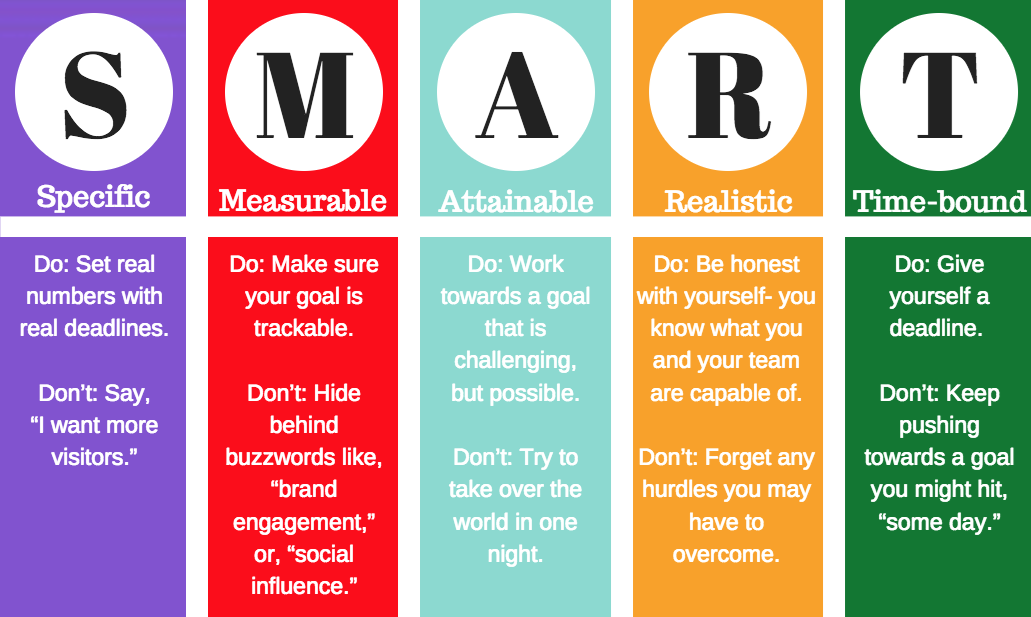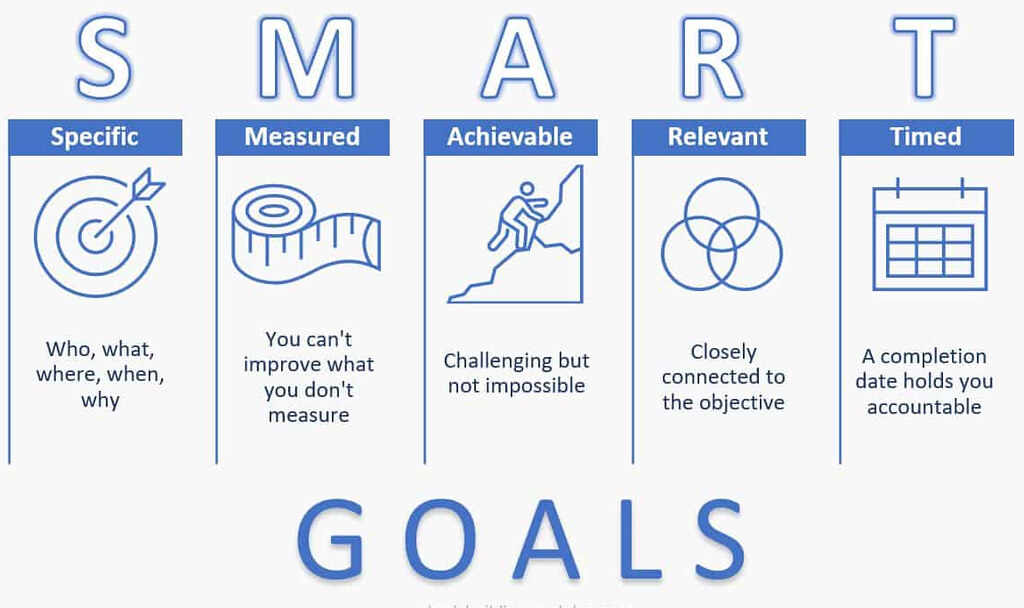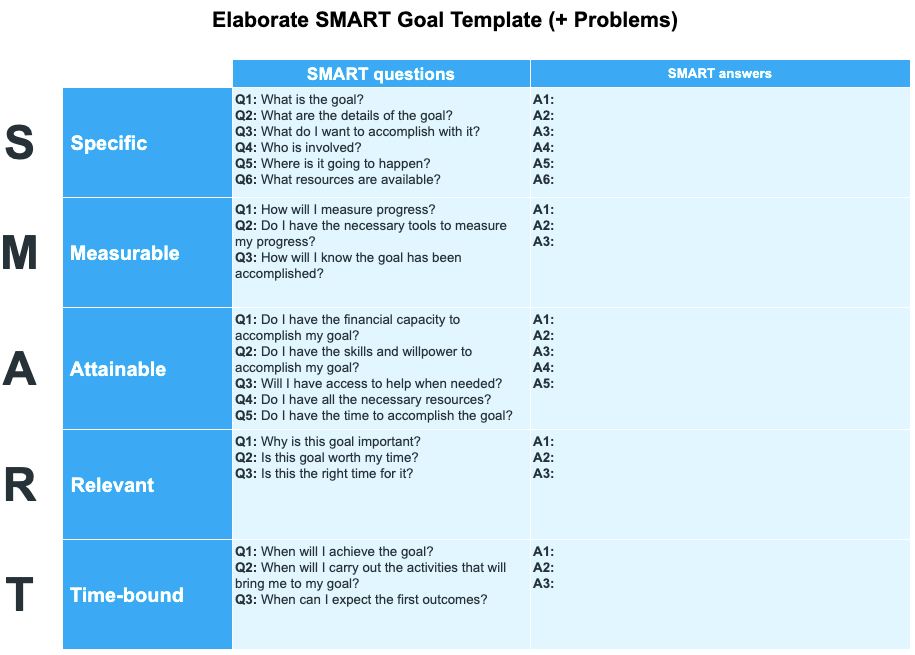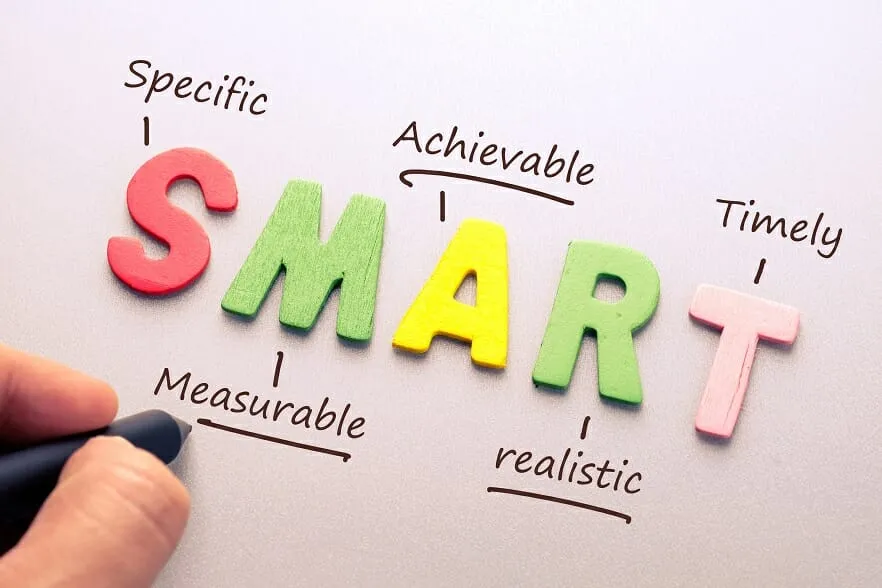To achieve success in life, setting clear and achievable goals is extremely important. The SMART method, with 5 criteria specific, measurable, attainable, relevant and time-bound, is one of the most useful tools to help us orient and achieve the goals we set. So what are SMART Goals?
What are SMART Goals?
What are SMART goal? This is a framework developed by George T. Doran in 1981. SMART is a popular framework for effective goal setting, which includes five specific criteria: Specific, Measurable, Achievable, Realistic and Time-bound. A SMART goal must clearly state exactly what needs to be achieved rather than being vague, must have indicators to measure progress and results, must be achievable with existing resources, must be directly related to the overall purpose and must have a specific completion deadline.

The SMART model includes 5 core criteria:
Specific
What is Specific? Specific is the first and most important criterion in the SMART framework, requiring goals to be described clearly, in detail, and focused on a specific result. Specific goals help you stay focused and know exactly what to do to achieve them. It also helps stakeholders track and evaluate results more clearly. The more specific the goal, the easier it is for you to plan and implement effectively.
Specificity requires that goals answer six basic questions:
- What: Identify exactly what you want to achieve
- Why: The reason and motivation
- Who (Ai): Responsible person and stakeholders
- Where: Location or scope of implementation
- When: Start and end time
- How: Method and manner of implementation
For example, instead of setting a goal of “increase sales,” you need to define “increase organic food sales in the Southern region by 30% through the expansion of 5 new stores and the implementation of a customer loyalty program.”
Measurable
Measurables help you track progress and evaluate results objectively. This requires creating clear KPIs and an effective tracking system. To ensure measurability, you need to build a comprehensive tracking and evaluation system, including setting up tracking tools (Google Analytics, CRM, dashboard), periodically collecting and analyzing data, and comparing it with the set goals. Therefore, setting KPIs and a regular reporting process is key to ensuring that goals are always under control.
For example, instead of “improve English skills”, set a goal of “achieve IELTS score 7.0 within 6 months with a minimum listening and speaking score of 7.0”.
Achievable
Feasibility does not mean setting an easy goal. Instead, you need to consider your existing resources (time, finance, human resources) and your actual ability to achieve the goal. When determining feasibility, you need to comprehensively assess your existing resources, including your organization’s internal capabilities, the experience and skills of your team, and available facilities and technology. You also need to consider objective factors from the external environment such as market conditions, industry trends, and competitor behavior. Achievable goals will motivate and inspire your organization, rather than causing unnecessary pressure.
Another important aspect of feasibility is risk analysis and management. You need to identify potential challenges in advance and prepare contingency plans. For example, if you set a goal of 30% sales growth next year, you need to assess your production capacity, distribution capabilities, investment capital, and marketing strategy in detail. If you find bottlenecks that could affect your goal, you need to adjust your plan or add the necessary resources to ensure the goal is feasible.
Realistic
What is Realistic? Realistic or realistic requires a comprehensive consideration of the organization’s expectations and existing resources. Unlike feasibility, which focuses only on the ability to achieve, realistic refers to the appropriateness of the goal to the specific context and conditions at the present time. You will need to make a detailed assessment of internal capacity (human resources, finance, technology), market conditions (competition, consumer trends), and macro-environmental factors (economic, policy, social). When building realistic goals, you need to avoid two extremes: being too ambitious, leading to failure, and being too conservative, leading to wasted growth potential.
Another important aspect of realism is the ability to adjust and adapt to change. Realistic goals need to be flexible enough to be able to adjust as market conditions change or new opportunities arise. For example, when setting a market expansion goal, instead of setting a rigid target of “opening 10 stores in a year”, a more realistic goal would be “opening 6-8 stores in the first year, focusing on high-potential areas, with a profit margin of at least 20% and a payback period of no more than 18 months”. This approach demonstrates both the ambition to grow and ensures the sustainability of the business through specific financial indicators.
Time-bound
This is what creates urgency and discipline in achieving goals. Setting deadlines is not just about setting a final milestone, but also knowing how to effectively allocate time for each stage of the project. The time frame needs to be divided into small milestones with clear progress checkpoints. From there, you can proactively monitor and adjust the plan, creating motivation through achieving small goals along the way.
When determining your time frame, you need to consider industry seasonality, business cycles, and environmental factors that may impact progress. In the retail industry, setting growth targets should take into account peak seasons such as Tet, Black Friday, or major events during the year. Contingency time should also be calculated to deal with unexpected situations. A good time plan will create enough pressure to drive performance while ensuring the flexibility needed to achieve goals sustainably.
The Meaning of SMART Goals
What does SMART goal mean? The content below will give you the details.
General Meaning
SMART goals include Specific, Measurable, Achievable, Realistic and Time-bound. Each of these elements has its own meaning:
- Specific: Ask the questions: “What is the goal?” and “What are the desired results after achieving the goal?”, clearly define what you want to achieve and specifically describe the direction and scope of the goal.
- Measurable: Ask the questions: “How is the goal?” and “How will we know if the goal has been achieved?”, identify criteria or metrics to track progress and evaluate the results of the goal.
- Achievable: Ask the questions: “Is the goal achievable?” and “Are there enough resources and capabilities to achieve the goal?”, determining whether the goal is feasible and achievable based on existing resources and capabilities.
- Realistic: Ask the questions: “Is the goal suitable for the current situation?” and “Do I have the conditions and capabilities to achieve the goal?”, make sure that the goal is reasonable and suitable for the current situation and that you have the conditions and capabilities to achieve that goal.
- Time-bound: Ask the questions: “What is the time frame for the goal to be achieved?” and “When is the end date?”, set a specific time frame to achieve the goal and ensure that the time set is reasonable and achievable.
Meaning in Marketing

In Marketing, SMART goals also have many other meanings, specifically:
Specific Goals
Specific goals play a fundamental role in the development strategy planning process. Instead of setting general goals such as “improve customer service”, you need to define clearly such as “reduce customer response time to a maximum of 2 hours, increase satisfaction rate to 95% by Q3/2024 through implementing a new CRM system and training 50 frontline employees”. This helps you clearly visualize the desired results, thereby determining the necessary resources, implementation steps and completion time for each stage.
The process of specifying goals also helps you thoroughly analyze influencing factors and predict possible challenges. For example, when you want to expand the market to a new area, you need to detail aspects such as: researching the behavior and needs of local customers, analyzing competitors, building a distribution network, and establishing a marketing plan suitable for the local culture. This detail helps you better prepare in terms of finance, human resources and other resources, and at the same time increases the likelihood of project success.
Increase Accuracy, Suitable For Target
The accuracy and relevance of the goal determines the feasibility of the implementation process. The goal should be built on a comprehensive analysis of the organization’s internal capabilities, including: technology level, human resource quality, financial capacity and corporate culture. You need to carefully evaluate external factors such as market trends, consumer behavior, legal policies and changes in the business environment to ensure that the goal is within the ability to achieve.
Increasing the accuracy of the target also requires consultation and contribution from many stakeholders. You need to organize meetings and workshops with different departments to collect information, opinions and multi-dimensional perspectives. This not only helps the target become more realistic but also creates consensus and commitment from members of the organization. You should also regularly update and adjust the target according to changes in the business environment to ensure the suitability and feasibility of the target.
Improving Measurability
Measurability is a key factor that helps you monitor and evaluate the effectiveness of your goals objectively. Setting up specific metrics such as ROI (return on investment), NPS (customer satisfaction index), conversion rate or time to complete work helps you grasp the progress and level of goal completion. You need to build a regular monitoring and reporting system, set important evaluation milestones to promptly detect and handle problems that arise during the implementation process.
To improve your measurement capabilities, you need to invest in technology and data management systems. You need to build dashboards, set up automatic warning systems when indicators are not meeting targets, and create detailed analytical reports. This will help you make faster, more accurate decisions, creating a basis for timely evaluation and adjustment of strategies.
Increase Work Productivity
Setting SMART Goals creates motivation and clear direction for every member of the organization, thereby boosting the productivity of the entire team. When everyone clearly understands their role, responsibility and contribution to the common goal, they will focus their resources and efforts on the most valuable activities. This helps eliminate unnecessary work, optimize work processes and enhance coordination between departments. You can apply management tools such as Kanban, Agile to track and coordinate work more effectively.
SMART Goals help people understand the results to be achieved and the deadline, thereby proactively planning and arranging work scientifically. It not only helps to minimize missed deadlines but also creates space for creativity and innovation in work. Achieving the set goals also creates a sense of success and satisfaction, promoting a positive working spirit.
Effective Time Management
Effective time management is a natural result of applying the SMART goal setting method. By dividing large goals into smaller goals with specific deadlines, you can plan in detail and allocate resources appropriately for each stage. You will avoid work pile-up, overload and ensure the project progress is on schedule. You can use time management tools such as the Eisenhower Matrix to categorize and prioritize tasks or apply the Pomodoro technique to increase focus and work efficiency.
Effective time management also involves the ability to anticipate and handle unexpected situations. By setting timelines in your plan, you can flexibly adjust and deal with unforeseen changes. This skill also helps you balance work and life, creating conditions for the comprehensive development of each individual.
How to Set SMART Goals

Setting SMART goals can be done by following these steps:
Goal Orientation
Defining your goals is an important first step, requiring you to conduct a thorough analysis of your current strengths, weaknesses, opportunities, and threats. This process begins with a comprehensive assessment of your capabilities, including: professional knowledge, soft skills, work experience, and network. You also need to carefully research industry trends, market demands, and changes in the work environment to ensure that your goals are both relevant to your personal potential and meet practical requirements.
In addition to considering objective factors, goal orientation is also a deep understanding of your core values and passions. You need to take time to reflect on what you truly want in life, not only in terms of material things but also in terms of spiritual growth and contribution to society. Combining personal ambition with social values will create sustainable motivation, helping you maintain enthusiasm and determination throughout the process of achieving your goals.
Write Your Goals Down on Paper
Putting your thoughts and ideas into writing not only helps to make your goals more specific but also increases your commitment to them. When writing them down, you need to follow the SMART model: Specific, Measurable, Achievable, Realistic and Time-bound. Each goal should be described in detail with specific metrics, a clear completion date and important milestones to achieve. This will turn abstract dreams into practical action plans.
The goal writing process is also an opportunity to organize and prioritize your goals. You can divide your goals into groups such as short-term (3-6 months), medium-term (1-2 years), and long-term (3-5 years). This categorization helps you focus your resources on the most important tasks, while also creating logical connections between your goals. You should also periodically review and update your list of goals to ensure they remain relevant to your current situation.
Building a Plan
Developing a plan is the step of converting goals into specific actions. This process requires you to carefully analyze the necessary resources, including time, finance, knowledge and support network. Each goal needs to be broken down into tasks with detailed timelines, responsible people and performance indicators. At the same time, you need to prepare contingency plans to handle risks and set up a progress monitoring system to ensure the plan is implemented on schedule.
During the planning process, it is helpful to set milestones to help you stay motivated and track your progress. For example, if you are setting goals for yourself in your career development this year, you might plan something like this:
- Month 1-3 complete new professional certification.
- April-June expand your network by participating in 3 important industry networking events.
- July-September carry out a breakthrough project to highlight your personal profile.
- October-December focus on preparing for a promotion or job change.
Each milestone needs to be associated with specific activities and clear evaluation indicators.
SMART Goal Examples

Here are examples of SMART goals in different fields:
Health Field
General Goal: Improve physical health through exercise and a scientific diet.
Specific goals according to the SMART model:
- Specifically (S): Reduce body weight by 8kg and reduce fat ratio to 18% through gym and jogging.
- Measurement (M): Track your weight weekly, measure your body fat percentage monthly, record your running miles and workout intensity.
- Possible (A): Sign up for a gym membership near your home, work out 4 times a week, 90 minutes each time.
- Realistic (R): Fits current work schedule and financial capacity.
- Time limit (T): Complete within 6 months, from January to June 2024.
Field of Work
General Goal: Advance career and develop professional skills.
Specific goals according to the SMART model:
- Specific (S): Achieve Project Manager position and increase income by 30% through completing PMP certification.
- Measure (M): Number of successfully managed projects, ratings from superiors and peers.
- Feasibility (A): Take the online PMP course, practice managing 2 small projects to gain experience.
- Reality (R): The company is looking to recruit a new Project Manager.
- Time-bound (T): Achieve goal within 12 months, complete certification within first 6 months.
Field of Study
For an example of SMART goals in learning, you can refer to the following:
General Goal: Improve foreign language proficiency to expand career opportunities.
Specific goals according to the SMART model:
- Specifically (S): Achieve IELTS certificate 7.0 with minimum Speaking and Writing component score 6.5.
- Measurement (M): Monthly test scores, study and practice hours.
- Feasibility (A): Study with native teachers 2 sessions/week, self-study 2 hours/day.
- Realistic (R): Appropriate to job requirements and financial capabilities.
- Time limit (T): Complete within 8 months, certification exam in September 2024.
Financial Sector
General Goal: Build investment and savings funds for the future.
Specific goals according to the SMART model:
- Specifically (S): Accumulate 200 million VND through savings and stock investment.
- Measure (M): Track monthly spending, return on investment.
- Feasible (A): Save 30% of monthly income, invest 20% in researched stock portfolio.
- Realistic (R): Based on current income and ability to control spending.
- Time-bound (T): Achieve the goal within 24 months, from 2024-2025.
Personal Development Area
General Objective: Develop leadership and communication skills.
Specific goals according to the SMART model:
- Specific (S): Be a speaker in 3 professional seminars and mentor 5 new employees.
- Measurement (M): Number of presentations, feedback from attendees, mentee progress.
- Possible (A): Join a Toastmasters club, take a coaching skills course.
- Reality (R): Appropriate for current role and development direction.
- Time Limit (T): Complete within 12 months of 2024.
Family Area
General Goal: Balance time for family and work.
Specific goals according to the SMART model:
- Specifically (S): Spend 2 nights/week on family activities and organize 4 short trips.
- Measure (M): Number of quality hours spent with family, number of activities done together.
- Feasibility (A): Arrange flexible work schedule, plan activities in detail.
- Realistic (R): Fits into work conditions and family budget.
- Time Limit (T): Lasts throughout 2024.
Social Area
General Goal: Expand network and contribute to the community.
Specific goals according to the SMART model:
- Specifically (S): Join 2 charity organizations and connect with 50 industry experts.
- Measurement (M): Volunteer hours, community projects participated in, new connections on LinkedIn.
- Possible (A): Attend monthly networking events, spend 4 hours/month on volunteering.
- Realistic (R): Matches interests and ability to contribute.
- Time Limit (T): Implementation in 2024.
Interest-Based Targeting
General Goal: To develop musical and creative talent.
Specific goals according to the SMART model:
- Specific (S): Learn to play guitar and compose 3 complete songs.
- Measurement (M): Hours of practice, number of songs mastered.
- Feasible (A): Study online 2 sessions/week, practice 30 minutes a day.
- Realistic (R): Fits into your interests and available free time.
- Time Limit (T): Achieved within 12 months of 2024.
Compare SMART Goals and OKRs
SMART and OKR are both useful performance management tools, but each method has its own unique characteristics and applications.
Similarities
- The goals all help improve productivity, motivate and orient the organization/individual.
- Progress can be tracked and evaluated.
- All have deadlines.
Differences
| Criteria | SMART | DISTRICT |
| Scope of application | Individual/Small Group | Organization/Company |
| Time of execution | Fixed, usually long term (6-12 months) | Flexible, short term (quarterly or 3 months) |
| Structure | 5 specific criteria (SMART) | Objective and Key Results (usually 3-5 OKRs) |
| Review frequency | End of term/by milestone | Continuous/Weekly |
| Flexibility | Less flexible, less changeable | High, adjustable to situation |
| Main purpose | Ensure goal completion | Promote innovation and development |
| Approach | Bottom up | Top to bottom |
| Measurement method | Specific quantification | Qualitative and quantitative combination |
Using SMART Goals helps you focus on important goals, increase performance to achieve success. By clearly defining and measuring progress, you can grasp potential, create motivation to overcome challenges. Start using SMART today to manage your goals more effectively!
Frequently Asked Questions
1. Is the SMART Model Suitable for New Startups?
This model is great for startups to set clear, measurable goals, but should be combined with OKRs to ensure flexibility.
2. When Should You Re-Evaluate Your SMART Goals?
You should review monthly and have an overall review every quarter; especially when new factors affect your ability to achieve your goals.
3. Should SMART Be Applied to All Goals at Work?
Not every goal needs to be SMART; short-term, simple, or experimental goals can use a different method to save time.
4. How to Adjust the SMART Model When Situations Change Suddenly?
The SMART model allows for flexibility as long as the five core criteria remain, so you can update metrics and timelines as needed.
Comment Policy: We truly value your comments and appreciate the time you take to share your thoughts and feedback with us.
Note: Comments that are identified as spam or purely promotional will be removed.
To enhance your commenting experience, consider creating a Gravatar account. By adding an avatar and using the same e-mail here, your comments will feature a unique and recognizable avatar, making it easier for other members to identify you.
Please use a valid e-mail address so you can receive notifications when your comments receive replies.
